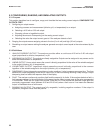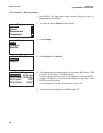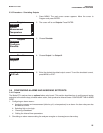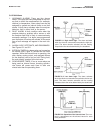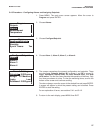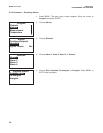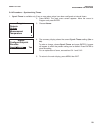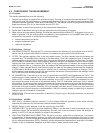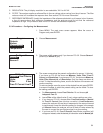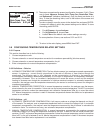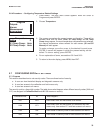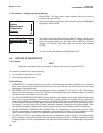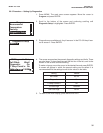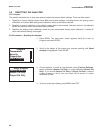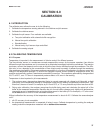
30
MODEL FCL-1056 SECTION 5.0
PROGRAMMING THE ANALYZER
5.5 CONFIGURING THE MEASUREMENT.
5.5.1 Purpose
This section describes how to do the following:
1. Program the analyzer to measure free chlorine (and pH). This step is necessary because the Model FCL ana-
lyzer can be used with other sensors to measure other chlorine oxidants. It can also be used to measure ORP
(oxidation reduction potential). When used in the Model FCL, the analyzer should be programmed to measure
either free chlorine (FCL-01) or free chlorine and pH (FCL-02).
2. Set automatic or manual pH correction for the free chlorine measurement.
3. Set the level of electronic filtering of the raw signals from the chlorine and pH sensors.
4. Make various pH measurement settings. The analyzer supplied with the Model FCL is designed to be as ver-
satile as possible. The pH settings below are needed in some applications, but are NOT used when pH is
measured for the purpose of correcting free chlorine readings.
a. solution temperature correction
b. analyzer isopotential point
c. reference impedance
5.5.2 Definitions - Chlorine
1. CHLORINE OXIDANTS. Although the FCL is used to measure free chlorine only, the analyzer used in the FCL
can be used to measure other chlorine oxidants, for example monochloramine and total chlorine.
2. FILTER: The analyzer applies a filter to the raw sensor current. The filter reduces noise but increases the
response time. The available filter(s) depend on the time setting. If the filter is between 0 and 10 seconds, the
analyzer applies a window filter. A window filter averages the measured value within the filter time. For exam-
ple, if the filter is 5 seconds and a step increase is applied to the input, the displayed value increases linearly,
reaching the final value after 5 seconds. If the filter is set to greater than 10 seconds, the analyzer applies
either an adaptive filter or a continuous filter. An adaptive filter discriminates between noise and real process
change. It filters changes below a fixed threshold value but does not filter changes that exceed the threshold.
It is best used in situations where the noise is relatively low. A continuous filter dampens all changes. The fil-
ter time setting is approximately equal to the time constant, the amount of time required for the reading to reach
63% of the final value following a step change.
3.
pH CORRECTION. Free chlorine is the sum of hypochlorous acid (HOCl) and hypochlorite ion (OCl
-
). The
relative amount of each depends on pH. As pH increases, the concentration of HOCl decreases and concen-
tration of OCl
-
increases. Because the sensor responds only to HOCl, a pH correction is necessary to prop-
erly convert the sensor current into a free chlorine reading. The FCL uses either continuous (live) or manual
pH correction. In continuous (live) correction the analyzer continuously monitors the pH of the sample and cor-
rects the free chlorine reading for changes in pH. In manual pH correction, the analyzer uses the pH entered
by the user for the pH correction. Generally, if the pH changes more than about 0.2 units over short periods of
time, continuous (live) pH correction is recommended. If the pH is relatively steady or subject only to seasonal
changes, manual pH correction is adequate.
4. RESOLUTION. If the chlorine concentration is less than 1.00 ppm (mg/L), the display resolution can be set to
0.XX or 0.XXX.
5.5.3 Definitions – pH/ORP
1. ORP. ORP is oxidation-reduction potential. It is the voltage difference between a noble metal indicator
electrode (like platinum) and a silver/silver chloride reference electrode.
2. REDOX. Redox is redox potential. It has the opposite sign from ORP.
3. PREAMPLIFIER. The pH signal has high impedance. Before it can be used, it must be converted into a low
impedance signal. The pre-amplifier accomplishes this task, and it can be located in either the analyzer or
sensor. In the FCL-02 the pre-amplifier is located in the analyzer.
4. SOLUTION TEMPERATURE CORRECTION. The pH of a solution, particularly an alkaline one, is a function
of temperature. If the temperature changes, so will the pH, even though the concentration of the acid or base
remains constant. Solution temperature compensation converts the pH at the measurement temperature to the
pH at a reference temperature (25ºC). Generally, solution temperature compensation is used only in the deter-
mination of pH in condensate, feedwater, and boiler water in steam electric power plants.



